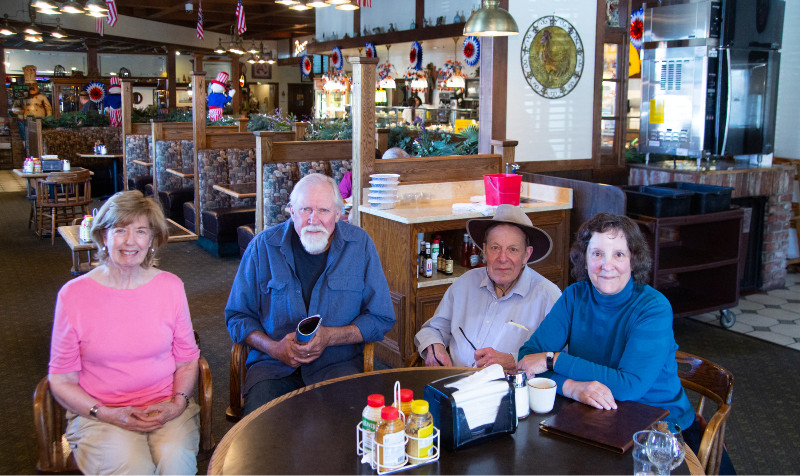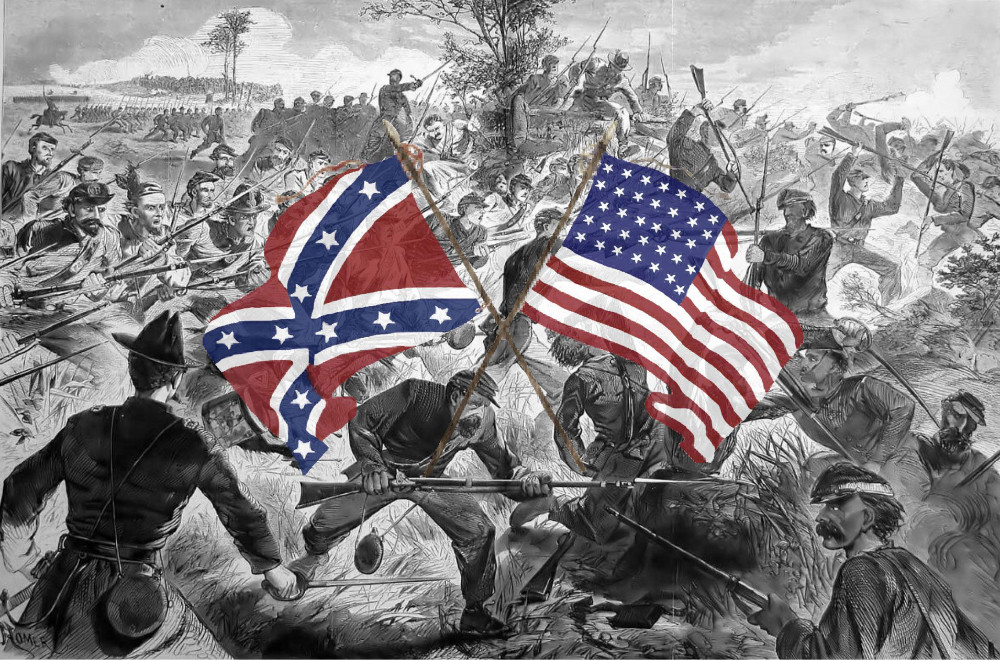Ever wonder how money orders got started? Or why dollar bills are sometimes called “greenbacks”? Or how steel ships came to replace wooden vessels?
They all date to the Civil War.
When people think of the devastating conflict of 1861-1865, they may picture blue-and-gray-uniformed soldiers charging one another with long-barreled guns and bayonets. They know the war ended slavery in the U.S. They may remember the names of famous battle sites like Gettysburg, Fredericksburg and Vicksburg. But few people may realize the war’s wider effects on American society and even warfare itself.
Without doubt, the most immediate results were the abolition of slavery and the reunification of the country. But consider something as routine (but also potentially hazardous) as sending money through the mail. According to the U.S. Postal Service, money orders were established in November 1864 so Union soldiers and ordinary citizens could send funds more securely than if they used easily stolen cash.
—
This story first appeared in the August edition of Climate Magazine
—
These days, that cash typically comes in “greenbacks” — a common nickname for U.S. paper money. The Federal Reserve Board’s U.S. Currency Education Program recalls that, in 1861, the Treasury Department began issuing “non-interest-bearing demand notes” to finance the war. They came in denominations of $5, $10, and $20, and represented loans to the government that could be redeemed at any time for face value. They served as money, and are still valid currency (although today they’re worth more to collectors). On the back, they were printed in green ink – hence, “greenbacks.”
Next, steel ships. The French navy is credited with the first iron-covered battleship, launched in 1859. But the “ironclads” gained prominence during the Civil War, when they proved superior to wooden vessels, which could more easily be blown apart by artillery shells. Eventually, iron gave way to steel for the hulls of modern ships.
Such are the many everyday products of the Civil War. And for the past half-century, they and other related subjects have propelled spirited discussions among the amateur history enthusiasts who meet every month under the banner of the Peninsula Civil War Round Table.
A Long Legacy
The group’s exact origins are, well, lost to history. But current members agree that the organization came into being around 1972 or 1973. (The first Civil War Round Table met in Chicago in 1941.) The local association once convened at now long-gone Salvatore’s Continental Restaurant on El Camino Real in San Carlos, a popular meeting spot for civic groups. Today, its membership gathers on the third Tuesday of each month at Harry’s Hofbrau in Redwood City to eat lunch, take in historical presentations and consider everything from 19th-century military tactics to the Civil War’s lasting imprint on American life.
“The Civil War is a historian’s delight,” says current president Abby Eller, adding, “It was the first large-scale, modern total war in history.” (Many historians agree; others consider World War I the first “modern” conflict and view the Civil War as an important precursor.)
That said, Eller continues: “It’s not much of an exaggeration to say that, ultimately, there was no corner of America, no household that was totally untouched by the Civil War and all the change that it brought about. It was really the transformative event in our country’s history.”

Quite a statement. But think about it. Today, nearly 160 years after the South surrendered in 1865, resentment lingers in many parts of the former Confederacy. And debates over states’ rights and federal power are as fresh as the Supreme Court’s overturning of Roe v. Wade this past June.
Alexander Hofmann, a Civil War scholar at the University of Chicago, notes Roe’s reliance on the Reconstruction-era Fourteenth Amendment, whose guarantee of due process underpinned the right to privacy described in the Supreme Court’s 1973 decision. The court’s recent ruling potentially casts doubt on that reasoning; as a consequence, Hofmann says, “Reconstruction amendments are literally being litigated through to the present.”
Overwhelming Advantages
In military terms, the Union’s victory demonstrated the importance of economic, industrial and technological superiority, at least in conventional warfare. The Civil War also introduced new weaponry, including “rifled muskets” whose grooved bores let soldiers fire up to 10 times farther than before, with much greater accuracy.
Historians disagree about whether those guns, along with the first repeating rifles, significantly influenced the outcomes on Civil War battlefields. Hofmann sides with those who believe the new weapons prevailed over old, Napoleonic tactics and contributed to a death toll now estimated at 750,000. As Hofmann puts it, “There were a lot of sitting ducks out there.”
It’s those kinds of issues that dominate the Peninsula Civil War Round Table’s lunchtime conversations. For example, how much did the Civil War affect global history? Eller’s husband Dave believes the impact was huge, particularly inasmuch as it spurred humanity’s ever-growing ability to spill blood since the mid-19th Century.
As Dave observes, ironclad ships weren’t the Civil War’s only developments to become broadly adopted. Machine guns also advanced (the hand-cranked Gatling gun was invented in 1861). Though employed relatively little during the Civil War, machine guns were used more commonly by World War I and were a staple of World War II.
Dave also points to the widely understood connections among economic dominance, technological innovation and military success. (A strong economy can lead to inventions such as the telegraph — vital to the North’s triumph — and turn commercial manufacturing into wartime production.)
“What became modern war was developed from the United States Civil War,” Dave says. “The whole world’s history since the Civil War is based on what happened in all these different ways.”
Freedom at Last
Fellow member Joan Larrabee often focuses on the war’s social consequences, especially the end of slavery and the official recognition of former slaves’ status as human beings, rather than property. Larrabee, whose extended family resided on both sides of the Mason-Dixon Line, tells of a distant relative who, according to lore, lost his Louisiana plantation in a card game. His opponent’s winnings included eight slaves. (The transaction, she says, is documented in government records found by her son.)
“To think that you could do that,” ponders Larrabee, her soft, calm voice conveying a combination of incredulity and indignation. “You could just transfer eight people, including a few babies, and they now have a new owner. It’s appalling, and I often wonder what happened to them.”
Another member, Magnus Akerblom, came to the U.S. from Sweden as a child in 1957. His interest in the Civil War stems largely from his desire to understand his adopted country. He estimates he has nearly 100 books about the conflict, and enjoys combing through them to obtain differing perspectives.
“Sometimes I find myself studying and looking at a specific topic like, maybe, the Battle of Gettysburg,” Akerblom says. “I’m looking something up, and then I get another book and I’m cross-referencing and checking things out. I just found that at Gettysburg there were 72,000 horses and they drank something like 3 million gallons of water. The logistics of that are fascinating.”
Round Table member Howard Jones’s ancestors fought for both sides. Jones has long been interested in history, and especially military history. On the oft-considered question of whether the Civil War could have been prevented, he believes the secession of 11 states shortly after President Abraham Lincoln’s election gave the new commander-in-chief little choice.
“Any president who takes the oath to preserve and protect the country, I think, is obligated to take action in a situation like that,” Jones says. “Politics then were pretty much like politics now. Everyone was in everyone else’s face. It doesn’t take much to set it off, (and) that one was a long time coming.”
What Started the War?
Along those lines, another frequent question: Was the war fought over slavery or union? Hofmann says historians “universally agree” on slavery as the cause, with the proviso that “from a northern standpoint, the conflict grew from a war for union to a war for emancipation.”
To the slavery argument, Akerblom emphasizes the Confederate states’ declarations of secession; along with “trial-balloon” correspondence among southern leaders, many of the formal statements directly or indirectly mentioned preserving enslavement. Akerblom also cites the January 1861 farewell speech of then-U.S. Senator Jefferson Davis, who became President of the Confederacy a month later. In his address to the Senate, Davis specifically referred to what he considered the U.S. Constitution’s acceptance of slavery, and spoke of his imperative “to withdraw from a government … (that) threatens to be destructive of our rights.”
The Ellers acknowledge slavery’s role, also noting that — at least in the beginning — Lincoln aimed primarily to maintain national unity. Dave mentions Lincoln’s August 1862 letter to newspaper publisher and Republican Party co-founder Horace Greeley, in which the President wrote, “If I could save the Union without freeing any slave I would do it, and if I could save it by freeing all the slaves I would do it; and if I could save it by freeing some and leaving others alone, I would also do that.” Even so, less than five months later Lincoln issued the Emancipation Proclamation, which outlawed slavery in the Confederate states and made freedom for slaves the centerpiece of the North’s purpose for prosecuting the war.
Nearly 120 years ago, the American philosopher George Santayana famously proposed that “those who cannot remember the past are condemned to repeat it.” If the Civil War was America’s most transformative event, it was also the most painful. In another era when, too, “everyone is in everyone else’s face,” the Peninsula Civil War Round Table offers a compelling forum for recalling the lessons of history.
More information about the Civil War Round Table: www.peninsulacivilwarroundtable.org
Climate thanks Dr. Alexander Hofmann of the University of Chicago history department for his perspectives on the information in this article.






